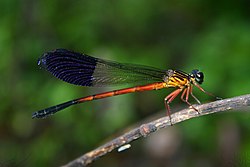Description and habitat
It is a medium-sized damselfly with black head and brown-capped pale grey eyes. Its thorax is black, marked with bright ochreous-red antehumeral and humeral stripes. Lateral sides of the thorax in the base is red. Its all legs are red. Wings are broader than Euphaea dispar . Fore-wings are transparent, merely infused with brown on the apices and almost in same length of the abdomen. Hindwings are transparent; but nearly half of the wings from the apices are broadly black. The black area of wings has steely-blue reflections in some lights. Abdomen is bright red up to the segment 6; apical third of segment 6 to the end segment are black. Anal appendages are black. [5]
Female is short and robust; the ochreous-red of male is replaced with yellow colors. All wings are transparent, infused with black in adults. Abdomen is black with yellow lateral stripes up to segment 6. The yellow lateral stripes continued to segment 7. Segment 8 has a narrow and 9 has a broad yellow apical annule, covering dorsal half. [5]
They breed in hill streams and usually find perched on boulders and riparian vegetation of streams. [5] [7] [8] [3] [4]
This page is based on this
Wikipedia article Text is available under the
CC BY-SA 4.0 license; additional terms may apply.
Images, videos and audio are available under their respective licenses.

